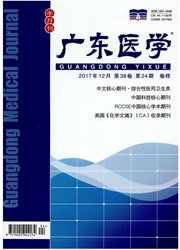

 中文摘要:
中文摘要:
目的 了解广州献血人群中丙型肝炎病毒(HCV)感染者自然转归与HLA多态性的相关性,为HCV治疗策略的制定、预后的评估及疫苗的研制提供科学依据。方法 选取广州献血人群中373例HCV感染者,分为两组:自发清除组(133例)和慢性感染者(240例),利用HLA-SBT方法对373份感染者进行HLA-Ⅱ类等位基因分型,用2检验分析每个HLA等位基因频率在自发清除组和慢性感染组的分布是否存在差异,并应用多因素Logistic回归对可能影响HCV自然转归的多种因素进行分析。结果 自发清除组与慢性感染组相比年龄较小[(28.2±9.9)岁vs(31.3±9.0)岁,t=-2.998,P=0.003],HCV自发清除组女性比例较高(34.6%vs 17.9%,2=13.090,P〈0.01)。DQB1*05:02(P=0.002,OR=0.411,95%CI=0.232~0.727)和DRB1*14:54(P=0.027,OR=0.350,95%CI=0.132~0.926)在慢性感染组中更为多见,DRB1*11:01在自发清除组较为常见(P=0.007,OR=2.169,95%CI=1.223~3.848)。多因素logistic回归分析发现,年龄(P〈0.01,OR=1.035,95%CI=1.018~1.053)、性别(P〈0.01,OR=0.423,95%CI=0.297~0.603)和DQB1*05:02(P=0.016,OR=0.480,95%CI=0.264~0.873)、DRB1*11:01(P=0.016,OR=2.072,95%CI=1.142~3.758)等位基因是HCV感染自然转归的独立相关因素。结论 女性、较年轻的HCV感染者比较容易发生自发清除,携带DQB1*05:02等位基因的人群在感染HCV后更易发生慢性化,携带DRB1*11:01基因则容易发生自发清除。
 英文摘要:
英文摘要:
Objective To evaluate the correlation between the natural outcomes of hepatitis C virus (HCV) infection and HLA polymorphism among Guangzhou blood donors, which could provide scientific data for treatment, prevention and vaccine development of HCV. Methods A total of 373 HCV infection blood donors, who donated in Guangzhou blood center, were recruited, including 133 blood donors with spontaneous HCV clearance and 240 with HCV persistent infection. Sequencing - based typing (SBT) methodology was used for detection of genotype HLA class Ⅱ alleles. The differences in allelic frequencies of HLA - DPB1, DQB1 and DRB1 between spontaneous clearance group and persistent infection group were analyzed using the χ^2 test. Multivariate logistic regression analysis was applied to identify independent factors associated with natural outcomes of HCV. Results The participants in spontaneous HCV clearance group were significantly younger (P = 0. 003 ) , and with significantly higher female/male ratio (34.6% vs. 17.9% , 2 = 13. 090, P 〈 0. 01 ) than those in HCV persistent infection group. HLA - DQB1 * 05:02 (P = 0. 002, OR = 0. 411, 95% CI = 0. 232 - 0. 727) and DRB1 * 14:54 (P=0. 027, OR=0. 350, 95%67=0. 132 -0. 926) were significantly more frequent in HCV persistent infection group, while the frequency of DRB1 * 11:01 was significantly higher in spontaneous HCV clearance group (P = 0. 007, OR = 2. 169, 95 % CI = 1. 223 - 3. 848 ). The following variables were found independently associated with HCV clearance, age ( P 〈 0.01, OR = 1. 035,95 % CI = 1. 018 - 1. 053 ) , gender ( P 〈 0.01, OR = 0. 423,95% CI = 0. 297 - 0. 603 ), and HLA - DQB1 * 05:02 (P = 0. 016, OR = 0. 480, 95 % CI = 0. 264 - 0. 873 ), and HLA - DRB1 * 11:01 (P =0. 016, OR = 2. 072, 95% CI = 1. 142 - 3. 758). Conclusion Our results show that female and young subjects are more likely to have HCV spontaneous clearance. After HCV infection, subjects who carry DQB1 * 05:02 are more likely t
 同期刊论文项目
同期刊论文项目
 同项目期刊论文
同项目期刊论文
 期刊信息
期刊信息
